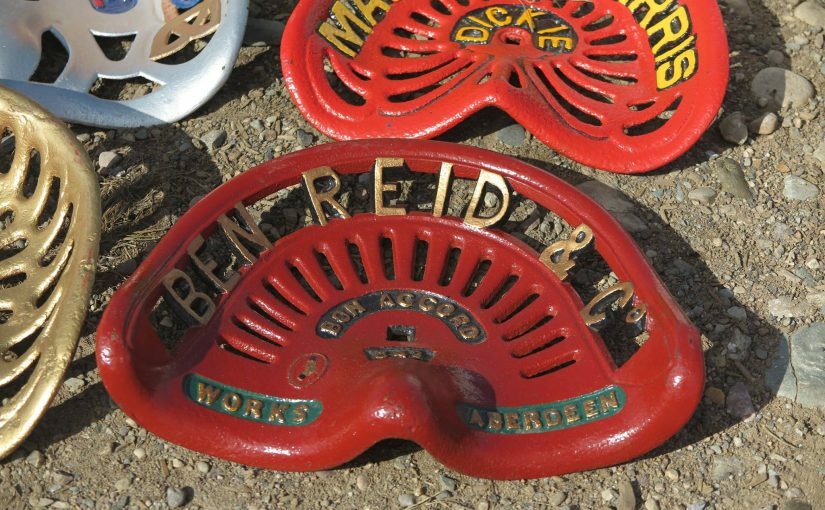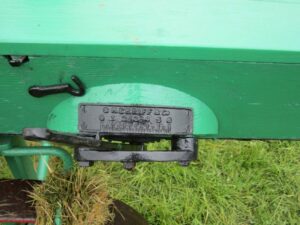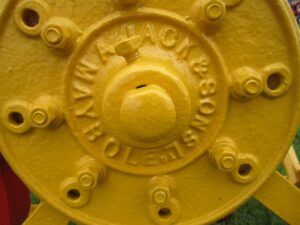The Census provides a good deal of information about individuals and the people around them. The 1871 Census provides some information on the size of the businesses of the key implement and machine makers in Scotland. This is through the number of people (usually “men”) that were employed by them.
The following list provides information on the size of some of the main implement making business in Scotland at a time when the implement trade was expanding rapidly and mechanisation becoming increasingly important:
Agnes Shirreff (Thomas Sherriff & Co., West Barns, East Lothian), agricultural implement maker employing 14 men and 3 boys.
John Kemp (Kemp & Nicholson, Stirling), ag implement manufacturer employing 49 men and 18 boys.
Joseph Henry Sams (of Ben, Reid & Co., Aberdeen), Old Machar, Aberdeenshire, agricultural implement maker employing 36 men and 19 boys.
Robert Wallace (Robert Wallace and Son), agricultural implement maker employing 8 men and 1 boy.
Alexander Young, Monifieth, agricultural implement employing 6 men.
George Finlayson, Gighty Burn, Kinnell, Forfarshire, agricultural implement maker employing 6 men.
Andrew Davidson, Banchory Devenick, Kincardineshire, agricultural implement maker (master employing 5 men).
Alexander Jack (Alexander Jack & Son), Maybole, agricultural implement maker employing 170 hands.
The list indicates that the size of the businesses varied very greatly, from small enterprises, to large enterprises such as Alexander Jack & Son which was the largest one.
Mrs Thomas Sherriff (Agnes Sherriff), West Barns, Dunbar, East Lothian, took over her husband’s business after his death. Thomas Sherriff was born in 1792, the son of a David Sherriff, farm servant, and Mary Sherriff (nee Ford), in Innerwick, a small largely agricultural parish in East Lothian with a population of 846 persons. He started his business at West Barns, in 1816. Shortly afterwards, on 5 December 1818, he married a local girl, Agnes Ponton.
Thomas was an innovator. In 1843 and 1844 news of his new grain cleaner spread as far away as Reading and Hereford. The local farmers at the wheat market, Haddington, surveyed it and gave the opinion that they “were highly satisfied of its valuable powers, and appeared most anxious that it should be introduced into the county with the least possible delay”. He continued to develop his implements, focusing on seed drills and sowing machines, though he also made other implements.
In 1852 Thomas started to exhibit at the General Show of the Highland and Agricultural Society of Scotland, the annual show of the national Scottish agricultural society. That year it was held in Perth. He returned to the following shows at Berwick in 1854, and Aberdeen in 1856. These were important shows, having the largest ever-recorded collections of implements on display, and at a time of increasing growth of the implement and machine industry and the mechanisation of Scottish agriculture. At each of these shows, Thomas displayed drill sowing machines for grain, horse hoes for drilled crops, broadcast sowing machines for grain and grass, and sowing machines for carrots. At the 1852 show he won a prize of £3 for a drill machine for grain and £4 for a horse hoe.
Thomas died on 15 December 1856, at the age of 64. Following his death, his wife Agnes decided to carry on his business. On 11 February 1857 she placed an announcement in the North British Agriculturist, the Scottish national agricultural newspaper of the day. It stated that “following her husband’s death, Mrs Sherriff intends to carry on the business as formerly, and asks for continued orders”. She named the business “Mrs Thomas Sherriff, West Barns”.
Mrs Sherriff built on the successful business that Thomas had set up. She became a regular advertiser in the North British Agriculturist, promoting a range of her implements and machines, and giving them a much wider profile. Her advertising allowed notice of them not only throughout Scotland, but also much more widely, as that newspaper was also widely read in England.
She continued to exhibit her manufactures at the General Show of the Highland and Agricultural Society of Scotland. Through the award of premiums at that at show, her business became the most highly decorated Scottish agricultural implement maker of the second half of the 1850s and early 1860s. No other implement maker came close. Her business was awarded no less than 32 awards between 1857 and 1861, including nine bronze medals.
Mrs Sherriff continued in business until 1871. On 19 July 1871 she placed a further notice in the North British Agriculturist announcing that “on this day Mrs Sherriff retired from business and transferred the business to her present manager Robert Robertson who will carry on the business, and who is authorised to pay all debts due to Mrs Sherriff to 6 July 1871.” Robert succeeded to the goodwill, stock in trade and tools of the business. He renamed the business “Thomas Sherriff & Co.”, thus starting another episode in the history of that business. He remained there until his death on 18 January 1906.
Alexander Jack & Son was well-known throughout Scotland from the 1830s until the early 1970s. Alexander Jack was first noted in the Scottish agricultural press in 1843 with the name and address Alexander Jack, Sawmill, Auchendrane, Maybole. By the early 1950s he described himself as a wood merchant at Culroy, Maybole.
By the late 1850s Alexander was joined by one son, and later into the early 1860s by another. The name Alexander Jack and Sons was to be known until 1905 when the company incorporated itself and became limited by guarantee as Alexander Jack & Sons Ltd. In 1930 it became the proprietor of another major Ayrshire maker – Thomas Hunter & Sons (Maybole) Ltd.
While the company was always based in Maybole, it opened a branch in Glasgow in the late 1870s. By 1879 its Glasgow premises was at 427 Gallowgate. With the move of the other implement makers to Graham Square, Alexander followed. By 1884 the company of implement makers and wood merchants was based at 20 Graham Square where it remained until at least the Second World War.
The company undertook a range of trades and activities – as agricultural implement makers, cartwrights, railway waggon builders, engineers, timber merchants, steam saw millers, smith and farrier, spring van and lorry builder and wood merchant. It was especially noted for its mowers and reapers, potato diggers and carts. In 1935 it noted how it had been a maker of Scotch carts for over 90 years.
By the 1870s the company also acted as an agent for a range of other makers. In 1875 they included W. N. Nicholson & Son, Newark On Trent, Ransomes, Sims & Head, Orwell Works, Ipswitch, John Williams & Son, Rhyl, Richmond & Chandler, Salford, Manchester, Picksley, Sims & Co. Ltd, Leigh, Lancashire, James Pattison, Hurlet. In 1909 they were International Harvester Co. of Great Britain Ltd, London, Cockshutt Plow Co. Ltd, Brantford, Canada.
The company was a regular advertiser in the Scottish farming press as well as a regular at the Royal Highland Show, where it travelled to all of the show districts. It also frequented major shows in Northern Ireland as well as the Royal Agricultural Society of England. In Scotland it did well at the shows, especially the Highland Show. For example, in 1859 it was awarded a bronze medal for second best sowing machine for turnips as well as other awards for Norwegian harrows, a one row sowing machine for beans. In the early 1870s it was awarded silver medals for its collection of implements and machines. But it was its potato raisers, such as its Caledonian, that won it national awards in England at the Royal Agricultural Society of England trials in 1896. This was a major accolade for a Scottish company against the major English players.



